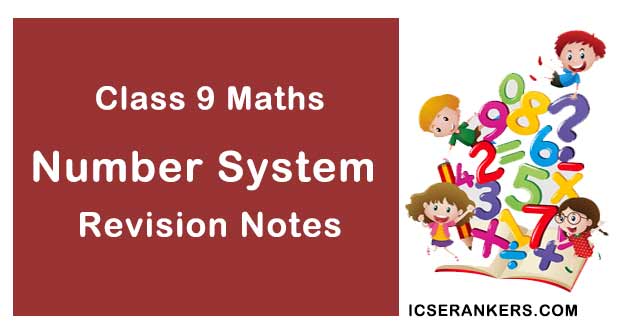NCERT Notes for Class 9 Maths Chapter 1 Number System

Class 9 Maths Chapter 1 Number System Notes
Chapter Name | Number System Notes |
Class | CBSE Class 9 |
Textbook Name | Mathematics Class 9 |
Related Readings |
|
Number Systems
Non-negative counting numbers excluding zero are called Natural Numbers.
N = 1, 2, 3, 4, 5, ……
Whole Numbers
All natural numbers including zero are called Whole Numbers.
W = 0, 1, 2, 3, 4, 5, ……
Integers
All natural numbers, negative numbers and 0, together are called Integers.
Z = – 3, – 2, – 1, 0, 1, 2, 3, 4, …………..
Rational Numbers
The number ‘a’ is called Rational if it can be written in the form of r/s where ‘r’ and ‘s’ are integers and s ≠ 0,
Q = 2/3, 3/5, etc. all are rational numbers.
How to find a rational number between two given numbers?
To find the rational number between two given numbers ‘a’ and ‘b’.![]()
Example: Find 2 rational numbers between 4 and 5.
Solution
To find the rational number between 4 and 5

To find another number we will follow the same process again.
Hence, the two rational numbers between 4 and 5 are 9/2 and 17/4.
Remark: There could be unlimited rational numbers between any two rational numbers.
Irrational Numbers
The number ‘a’ which cannot be written in the form of p/q is called irrational, where p and q are integers and q ≠ 0 or you can say that the numbers which are not rational are called Irrational Numbers.
Example: √7, √11 etc.
If we do the decimal expansion of an irrational number then it would be non–terminating non-recurring and vice-versa i.e. the remainder does not become zero and also not repeated.
Example:
π = 3.141592653589793238……
Real Numbers
All numbers including both rational and irrational numbers are called Real Numbers.
R = –2, –(2/3), 0, 3 and √2

Real Numbers and their Decimal Expansions
Rational Numbers
If the rational number is in the form of a/b then by dividing a by b we can get two situations.
- If the remainder becomes zero
While dividing if we get zero as the remainder after some steps then the decimal expansion of such number is called terminating.
Example: 7/8 = 0.875 - If the remainder does not become zero
While dividing if the decimal expansion continues and not becomes zero then it is called non-terminating or repeating expansion.
Example: 1/3 = 0.3333….
It can be written as
Hence, the decimal expansion of rational numbers could be terminating or non-terminating recurring and vice-versa.
Representing Real Numbers on the Number Line
To represent the real numbers on the number line we use the process of successive magnification in which we visualize the numbers through a magnifying glass on the number line.
Example: ![]()
Step 1: The number lies between 4 and 5, so we divide it into 10 equal parts. Now for the first decimal place, we will mark the number between 4.2 and 4.3.
Step 2: Now we will divide it into 10 equal parts again. The second decimal place will be between 4.26 and 4.27.
Step 3: Now we will again divide it into 10 equal parts. The third decimal place will be between 4.262 and 4.263.
Step 4: By doing the same process again we will mark the point at 4.2626.

Operations on Real Numbers
The sum, difference, product and quotient of two rational numbers will be rational.Example:
If we add or subtract a rational number with an irrational number then the outcome will be irrational.
Example: If 5 is a rational number and √7 is an irrational number then 5 + √7 and 5 - √7 are irrational numbers.
If we multiply or divide a non-zero rational number with an irrational number then also the outcome will be irrational.Example: If 7 is a rational number and √5 is an irrational number then 7√7 and 7/√5 are irrational numbers.
The sum, difference, product and quotient of two irrational numbers could be rational or irrational.Example:

Finding Roots of a Positive Real Number ‘x’ geometrically and mark it on the Number Line
To find √x geometrically
- First of all, mark the distance x unit from point A on the line so that AB = x unit.
- From B mark a point C with the distance of 1 unit, so that BC = 1 unit.
- Take the midpoint of AC and mark it as O. Then take OC as the radius and draw a semicircle.
- From the point B draw a perpendicular BD which intersects the semicircle at point D.

The length of BD = √x.
To mark the position of √x on the number line, we will take AC as the number line, with B as zero. So C is point 1 on the number line.
Now, we will take B as the centre and BD as the radius, and draw the arc on the number line at point E.

Now, E is √x on the number line.
Identities Related to Square Roots
If p and q are two positive real numbers then,

Examples:

Rationalizing the Denominator
Rationalize the denominator means to convert the denominator containing square root term into a rational number by finding the equivalent fraction of the given fraction.
For which we can use the identities of the real numbers.
Example: Rationalize the denominator of 7/(7- √3).
Solution

Laws of Exponents for Real Numbers
If we have a and b as the base and m and n as the exponents, then
- am× an = am+n
- (am)n = amn

- ambm = (ab)m
- a0 = 1
- a1 = a
- 1/an = a-n


Example: Simplify the expression (2x3 y4) (3xy5)2.
Solution
Here we will use the law of exponents
am × an = am+n and (am)n = amn
(2x3y4)(3xy5)2
= (2x3y4)(32 x2y10)
= 18. x3. x2.y4. y10
= 18. x3+2. y4 + 10
= 18x5y14

